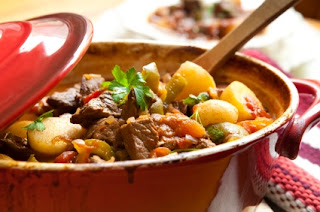I know exactly her problem! I’ve been trying to eat gluten-free for some years, and have had to take it seriously in the past 12 months, once we discovered I have one gene for coeliac disease, and therefore can’t tolerate gluten. To compound the problem, as part of my diet to keep me strong and healthy while suffering ITP, I’m also on a lowish-carb diet and avoiding all grains (as much as possible).

So I can reassure this person – and anyone else with a gluten-tolerance problem – that every cake and cookie, quiche or slice I put up on this blog has been made gluten-free.
Gluten-free pear and almond loaf
Is it hard to substitute when cooking gluten-free?
The honest answer is yes – at first. I was fortunate in having a good friend who is both a nutritionist and married to someone with coeliac disease, so she was very experienced in cooking gluten-free. She passed on some basic cookie and cake recipes, which I still use. From them, I got the basics of substitution.
The main problem is that gluten-free flour does not respond in the same way as wheat flour. It has much less body without the gluten, and often doesn’t rise as well, take up the same amount of liquid as wheat flour, or cook in the same time. Some flours, like rice flour and corn flour (corn starch) are very light. Soy flour, on the other hand, is quite heavy, and has a strange smell, which fortunately disappears in cooking. Soy flour and besan flour (chickpea flour), another heavy one, are best combined with lighter flours.
So you experiment. Be prepared for failures, or more likely, not quite perfects. Once you get the hang of it and find a flour or combination of flours you like, gluten-free cooking is just as much fun and the results as delicious as cooking with wheat flour. (I say wheat, because that’s mainly what flour is, but if you’re avoiding gluten, don’t forget to by-pass rye and oats. No more rolled oats, but brown rice flakes make a perfect substitute.)
Commercial gluten-free flours
Commercial gluten-free flour mixes, while more expensive than wheat flour, are fairly easy to find at your supermarket or health food store. Before I had to avoid grains, I found a commercial mix of rice flour, soyflour and tapioca quite good, although it was rather lumpy and needed sifting two or three times.
Now I use Orgran all-purpose flour, which is made from maize starch (corn flour), tapioca flour, rice flour and guar gum. It’s a lighter mix, and the ratio of rice flour to other ingredients is lower. I don’t usually endorse commercial products, but I’ve found this mix very easy to use, with consistently good results.
For some recipes, such as the pear and almond cake, and the next recipe, I add a bit of extra body by substituting with a couple of tablespoons of besan flour.
So, to the recipe: Beetroot Chocolate Brownies
This is my take on Hugh Fearnley-Wittingstall's Chocolate and Beetroot Brownies. I was quite taken by his idea of treating beetroot as a fruit, and copied the recipe a couple of years ago, before I got serious about baking gluten-free. Now I've modified it to omit the wheat flour.
250g (10oz) dark chocolate (preferably 70% cocoa solids), broken into pieces, or dark chocolate chips
250g (10oz) unsalted butter, cut into cubes, plus more for greasing
250g (10oz) caster sugar
3 free-range eggs
150g gluten-free flour (1½ cups), plus 2 tablespoons of besan flour
baking powder (baking soda) to make flour mix rise
250g of beetroot, boiled until tender, peeled and grated or chopped very fine
A 20x30x3cm (8x12x1 inch) baking tray (known in Australia as a Swiss roll or lamington tray)
Turn the oven on to 180C (350F). Put the chocolate and butter in a heatproof bowl or jug, and put on a lower shelf in the oven to melt. When partly melted, stir, and put back for a few more minutes to melt completely.
Meanwhile, beat the eggs and sugar together, and in a separate bowl, sift the flours and baking powder together. Cut or grate your cooked beetroot.*
When the butter and chocolate are melted, mix them, a little at a time into the egg and sugar mixture. Then fold in the sifted flour very gently, and lastly, the beetroot. Do not beat, just mix together gently.
Pour mixture into a greased and lined tray, smooth the top, and bake in the top of the preheated oven until just cooked. According to H F-W “a knife or skewer pushed into the middle should come out with a few moist crumbs clinging to it. Don't be tempted to overcook them!”
 He says 20 minutes should be long enough. However, whether because of the g-f flour, the fairly large eggs, or a slightly lower oven temperature, my brownies took 30 minutes. Test every few minutes after the 20 minute bell.
He says 20 minutes should be long enough. However, whether because of the g-f flour, the fairly large eggs, or a slightly lower oven temperature, my brownies took 30 minutes. Test every few minutes after the 20 minute bell.
Leave to cool in the tray before cutting into squares. Makes 24.
*To cook beetroot: Scrub gently under cold water, but do not cut roots off or peel the vegetables. Put in a large pot with plenty of water, cover, bring to the boil, then simmer for 30 minutes, or until tender. Allow to cool slightly, then, protecting your hands with rubber gloves, slip the peel off and remove the roots.
Buon appetito!





